SaaS, or Software as a Service, is a modern approach to software distribution and usage. This cloud-based model offers numerous…
Understanding saas,its benefits and examples
admin
- October 14, 2023
2 min read

SaaS, or Software as a Service, is a modern approach to software distribution and usage. This cloud-based model offers numerous advantages to businesses and individuals alike. In this article, we’ll explore what SaaS is, delve into its benefits, and provide real-world examples to illustrate its relevance in today’s digital landscape.
Understanding SaaS
SaaS, short for Software as a Service, is a cloud computing model where software applications are hosted and delivered over the internet. Instead of installing software on individual devices, users access and use these applications through web browsers.
Accessibility:
SaaS solutions are accessible from virtually anywhere with an internet connection. This accessibility is a cornerstone of its convenience and utility.
Subscription-Based:
SaaS operates on a subscription-based model. Users pay recurring fees to access the software, eliminating the need for upfront purchase costs and ongoing maintenance expenses.
Benefits of SaaS
Cost-Efficiency:
SaaS eliminates the need for costly hardware and software installations. Businesses can allocate resources more effectively, and individuals can access powerful software without major financial outlays.
Automatic Updates:
SaaS providers handle software maintenance, including updates and security patches. This ensures that users always have access to the latest features and protection against vulnerabilities.
Scalability:
SaaS applications can be easily scaled up or down to accommodate changing user needs, making it an ideal choice for businesses experiencing growth or fluctuating demand.
Collaboration:
Many SaaS solutions support collaboration among multiple users, fostering teamwork and enhancing productivity.
Real-World Examples
Microsoft 365:
Formerly known as Office 365, Microsoft 365 offers a suite of productivity tools, including Word, Excel, and PowerPoint, accessible online.
Salesforce:
Salesforce is a widely-used customer relationship management (CRM) SaaS platform, helping businesses manage their sales, marketing, and customer service operations.
Adobe Creative Cloud:
Adobe’s Creative Cloud includes industry-standard design and creativity applications like Photoshop, Illustrator, and InDesign, available as SaaS.
Conclusion
SaaS, or Software as a Service, is a cloud-based software distribution model that delivers accessibility, cost-efficiency, and collaboration capabilities. Real-world examples like Microsoft 365, Salesforce, and Adobe Creative Cloud demonstrate how SaaS has become an integral part of both individual and business software usage, offering convenience, flexibility, and continuous innovation.
Tags
Our New Letter
Get productivity tips delivered straight to your inbox
Ready for more?

Arowiz Technologies is a Central India-based customer Centric software development & Expert IT Staff Augmentation company ...
FOR JOBS
hr@arowiz.comFOR SALES
sales@arowiz.comMARKETING / BLOGS
info@arowiz.comGET CONNECTED
Top Industry
About Us
Top Services
Hire Expert Developers
- AI / ML Developers
- Blockchain Developers
- DevOps Developers
- Web3 / Gaming Developers
- Full Stack Developers
- AR / VR – Meta Developers
- Python Developers
- Solidity Developers
- Node.js Developers
- ReatJs Developers
- Next.Js Developers
- Flutter Developers
- React Native Developers
- Golang Developers
- Mobile App Developers







